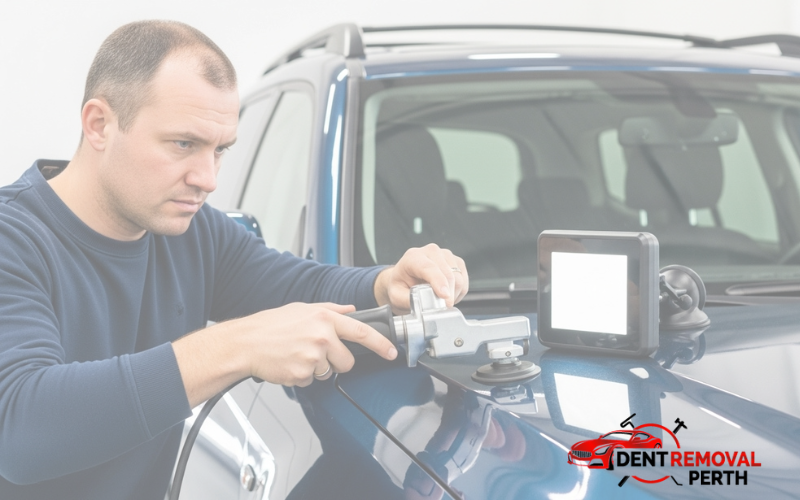
LED Inspection Mastery: Professional Paint Defect Detection Techniques
August, 08 2025Mastering paint defect identification is the foundation of any successful correction project. Whether you're working on luxury vehicles or daily drivers, understanding what you're looking at determines your entire approach and success rate.
Vehicle Assessment: Tailoring Your Inspection Strategy
The first rule of professional paint inspection: no two cars are identical. Your inspection strategy must adapt to each vehicle's unique history and characteristics.
Luxury Vehicle Inspection Protocol
High-end vehicles like Ferrari, McLaren, and Aston Martin typically present specific challenges:
- Primary concern: Factory sanding marks (universal issue)
- Secondary issues: Hologram patterns from improper rotary use
- Factory finish problems: Buffer marks from dealership prep
Classic/Restored Vehicle Analysis
Older vehicles requiring restoration present different inspection priorities:
- Paint blend inconsistencies from previous repairs
- Rotary-induced hologram patterns
- Washing-related swirl accumulation
- Impact scratches from daily use
- Chemical etching and solvent pop issues
Paint Thickness Analysis: Your Roadmap to Success
| Measurement Range | Implications | Correction Approach |
|---|---|---|
| 120+ microns | Factory thickness, full correction possible | Aggressive compound to fine polish |
| 80-120 microns | Previous work done, moderate correction | Medium compound, careful monitoring |
| 60-80 microns | Limited material available | Light polish only, minimal removal |
| <60 microns | Danger zone | Spot treatment, avoid full correction |
LED Light Inspection: Reading the Paint's History
Essential Equipment Setup
Your LED inspection light becomes your diagnostic tool for uncovering the paint's complete story. Proper lighting reveals defects invisible under standard illumination.
Systematic Panel Examination
Move methodically across each panel, noting:
- Defect density patterns
- Scratch orientation and depth
- Reflection consistency
- Previous correction evidence
Defect Classification System
Category 1: Surface-Level Imperfections
Characteristics:
- Micro-scratches from improper washing techniques
- Towel-induced marring
- Quick detailer application marks
- Automatic wash damage
Visual Identification: Consistent web-like patterns across painted surfaces, creating a hazy appearance that masks the true paint color.
Correction Approach: Multi-step process beginning with moderate cutting compound, progressing through finer abrasives.
Category 2: Mechanical Damage
Deep Scratch Assessment Technique: The fingernail test remains the industry standard - scratches catching your nail typically exceed safe correction depths.
Risk Management Principles:
- Material removal calculations
- Clear coat preservation priorities
- Long-term paint integrity considerations
- Future maintenance accessibility
Category 3: Professional Tool Marks
Swirl Patterns vs. Hologram Signatures
| Defect Type | Visual Characteristics | Light Behavior | Origin |
|---|---|---|---|
| Standard Swirls | Spider-web consistency | Static under light movement | Improper washing/drying |
| Holograms | Tentacle-like extensions | Dynamic with viewing angle | Rotary buffer misuse |
| Buffer Marks | Circular patterns | Semi-static | Orbital sander marks |
Advanced Inspection Techniques
Pattern Recognition Methodology
When performing systematic inspection, defect patterns tell the vehicle's maintenance story:
Consistent Defects Across Panels: Indicates owner-induced damage from washing practices Isolated Problem Areas: Suggests professional work or isolated incidents
Mixed Patterns: Evidence of multiple repair/correction attempts
Professional Assessment Criteria
Surface Preparation History
- Factory finish integrity
- Previous correction evidence
- Repaint quality indicators
- Blend zone identification
Correction Feasibility Analysis
- Available clear coat thickness
- Defect penetration depth
- Risk-to-benefit calculations
- Client expectation management
Realistic Outcome Planning
The 95% Correction Philosophy
Professional-grade correction targets 95% defect removal for practical reasons:
Why Not 100%?
- Physics limitations: Some defects exceed safe correction depths
- Access restrictions: Machinery cannot reach every surface contour
- Material conservation: Preserving clear coat for future maintenance
- Economic efficiency: Diminishing returns on final 5% effort
Client Communication Strategy
Setting appropriate expectations prevents disappointment and builds trust:
- Document uncorrectable defects during initial assessment
- Explain material removal limitations in understandable terms
- Highlight improvement areas rather than focusing on remaining imperfections
- Provide maintenance guidance for preserving results
Professional Best Practices
Recommended Procedures:
- Complete paint thickness mapping before beginning
- Document defect types and locations systematically
- Calculate safe material removal limits per panel
- Plan correction strategy based on findings
- Prioritize long-term paint health over immediate perfection
Practices to Avoid:
- Skipping comprehensive pre-correction inspection
- Attempting 100% defect removal regardless of depth
- Using identical approaches for different vehicle types
- Ignoring paint thickness limitations
- Sacrificing future correction potential for immediate results
Correction Strategy Development
Defect-Specific Approaches
Wash-Induced Swirls:
- Origin: Incorrect washing/drying methods
- Treatment: Progressive abrasive reduction
- Difficulty Level: Moderate - responds well to systematic approach
Rotary-Induced Holograms:
- Origin: Improper professional correction attempts
- Treatment: DA polisher correction, sometimes single-step resolution
- Variables: Previous operator skill level and equipment condition
Mechanical Scratches:
- Assessment Priority: Depth evaluation using tactile methods
- Treatment Philosophy: Improvement over elimination when depth prohibits safe removal
- Success Metrics: Visual improvement without compromising paint integrity
Quality Assurance Protocols
Inspection Validation Process
- Initial assessment documentation
- Progress monitoring at correction stages
- Final quality verification under multiple lighting conditions
- Client walkthrough and approval
Long-Term Success Indicators
- Paint clarity improvement
- Reflection depth enhancement
- Color saturation restoration
- Gloss level consistency
Conclusion: Inspection Excellence Drives Results
Thorough defect identification using proper LED inspection techniques forms the foundation of every successful paint correction project. Understanding what you're examining, recognizing correction limitations, and planning appropriate approaches ensures both immediate visual improvement and long-term paint preservation.
The goal isn't perfection - it's dramatic enhancement while maintaining the substrate's integrity for years of future enjoyment. Master these identification principles, and your correction work will consistently deliver professional-quality results that satisfy clients and preserve vehicle value.
